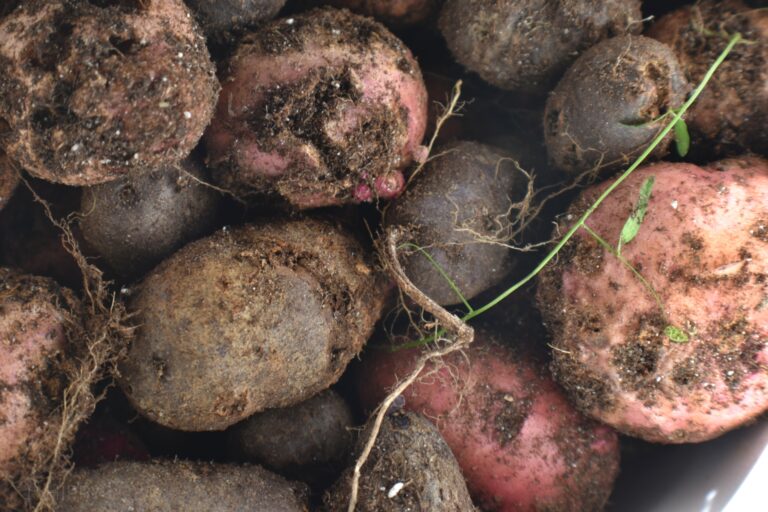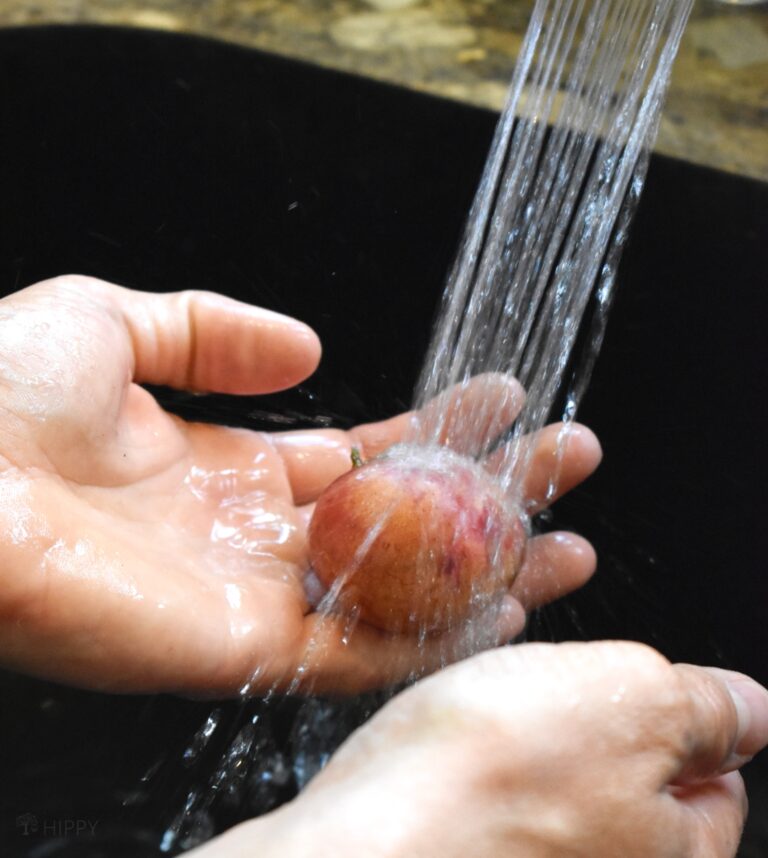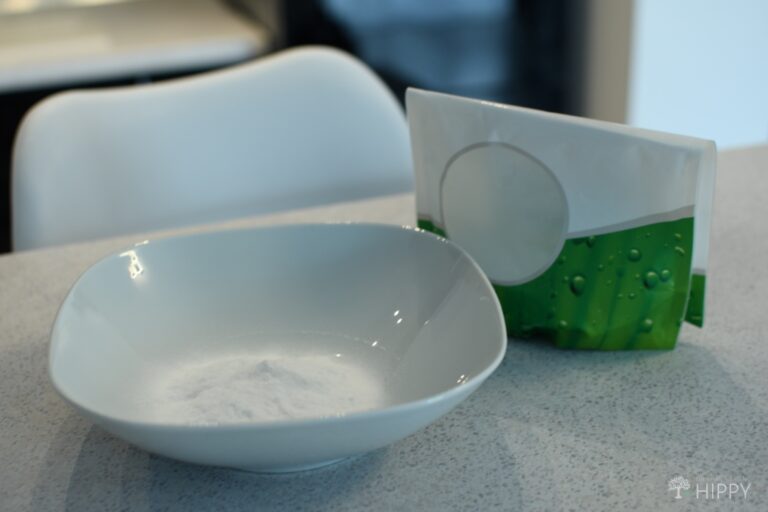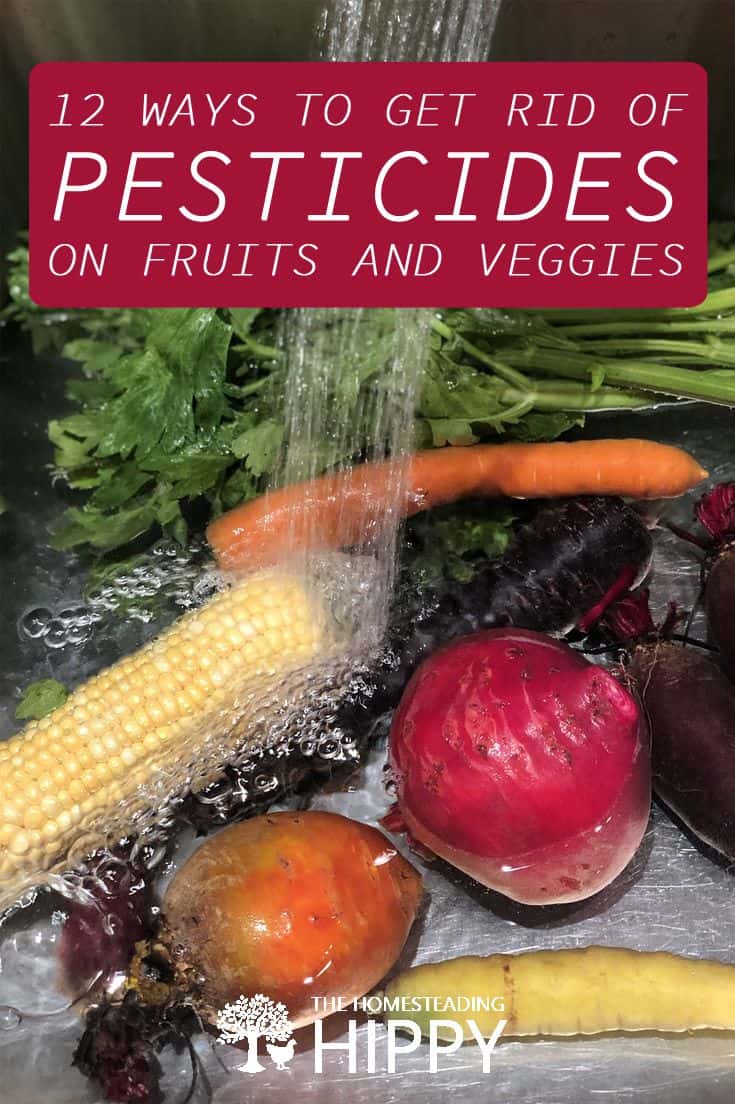If you’re trying to reduce the number of chemicals that you expose your body to, your food is a great place to start.
Unless you can organically produce 100% of all of the food you eat on your own property, the reality is that you are going to have to buy produce treated with herbicides and pesticides at one point or another.

Even if you grow most of your own food, you may be wondering how you can safely remove traces of chemicals from your fruits and vegetables.
Turn to the Internet, and you’ll find all kinds of solutions. Unfortunately, many of them are marketed in an effort to get you to spend even more money – and even more unfortunately, lots of them don’t actually work.
Here are some ways you can get rid of pesticides on fruits and veggies – that don’t require you to spend a ton of money and that actually work.
Why Is it Important to Get Pesticides off Fruit and Vegetables?
The first – and most obvious reason – is that you don’t want unnatural chemicals neutering your body.
In short, pesticides are made up of chemical-based ingredients that help repel pests and other insects. In this article, I’ll use the term “pesticide,” but these tips can also apply to herbicides (used to kill weeds) and fungicides (to prevent and eliminate fungal diseases), too.
Unfortunately, although these chemicals are effective at doing the job for which they are intended, they leave behind a lot of residues. These residues easily contaminate farm produce and can make you sick.
Plenty of scientific research in recent years has proven that extensive use and consumption of pesticides can cause chronic and severe health issues. When you’re exposed to pesticides at a high level, you may suffer from headaches, nausea, abdominal pain, and more.
The long-term effects of pesticide consumption are just too scary to mention…
What Are the Most Common Pesticides Used on Fruits and Vegetables – and Why Are They Problematic?
Pesticides are chemicals that are used to kill pests, like insects, weeds, or fungi. While they can help farmers grow bigger and better crops, they can also be harmful to our health. In this blog post, we’ll take a look at some of the most common pesticides used on fruits and vegetables – and why they can be problematic.
Glyphosate is a herbicide that is commonly used on crops like corn, soybeans, and wheat. It is also the active ingredient in Roundup, a popular weed killer. Glyphosate works by inhibiting an enzyme that is necessary for plant growth. While it is effective at killing weeds, it can also be harmful to human health. Studies have linked glyphosate exposure to an increased risk of cancer, reproductive problems, and developmental delays.
Atrazine is another herbicide that is commonly used on corn and other crops. It works by preventing the growth of weeds. Atrazine has been linked to endocrine disruption, which means it can interfere with the hormone system. This can lead to problems like infertility, birth defects, and cancer.
Chlorpyrifos is an insecticide that is commonly used on crops like apples, oranges, and strawberries. It works by disrupting the nervous system of insects, causing them to die. Unfortunately, chlorpyrifos can also be harmful to human health. Studies have linked chlorpyrifos exposure to an increased risk of developmental problems, reproductive problems, and cancer.
Heptachlor is an insecticide that was historically used on cotton fields. It works by disrupting the nervous system of insects, causing them to die. Heptachlor has been banned in the United States since 1988 due to concerns about its potential health effects; however, it may still be present in food grown in other countries. Studies have linked heptachlor exposure to an increased risk of cancer.
Should I Buy a Commercial Produce Wash?
Many people worry about the safety of their fruit and vegetables, and rightly so. Pesticides are designed to kill, after all. While some residues will wash off in water, others are more stubborn. So what’s a concerned shopper to do?
The FDA in the United States does not recommend washing fruits and vegetables with soap, detergent, or commercial produce wash. They have not been proven to be any more effective than water alone. This is because most pesticides are water-resistant. While washing may remove some residues, it’s unlikely to remove them all.
No washing method is 100% effective for removing all pesticide residues. However, there are some things you can do to reduce your exposure.
First, buy organic produce whenever possible. This is the best way to avoid pesticides altogether. Second, wash your fruits and vegetables thoroughly with water (and by following some of the steps that I’ll outline for you below).
You may not be able to remove all the residues, but every little bit helps.
Finally, eat a variety of fruits and vegetables. This will help to ensure that you’re not exposed to large amounts of any one specific pesticide.
How to Reduce Your Likelihood of Pesticide Exposure from Produce: 12 Best Tips
Whether you’re worried about DDT, chlorpyrifos, or some other insecticides on your produce, follow these tips to help protect yourself from exposure.
#1. Cold Water Wash
There are plenty of store-bought fruit and vegetable washes you can buy, but sadly, most of them don’t work.

In most cases, all you need’s a little bit of water, and occasionally, some elbow grease.
The extent to which washing with plain water will help clean your fruits and vegetables will depend largely upon her fruit or vegetable itself. Some are quite amenable to a bit of basic scrubbing, while others will retain some pesticides even if you wash them thoroughly.
Apples, for example, are often treated with wax to make them shinier. They will retain some pesticides even if you scrub intensely. However, a fruit and vegetable wash that you buy from the store won’t be any more effective than this and really, isn’t worth your money.
Don’t use dish soap or bleach to clean your produce, either. Not only can it become trapped and even absorbed by the process for chef fruit – making it difficult to rinse off once it’s been applied – but it can leave your food tasting funky, too.
#2. A Saltwater Soak
There is some evidence that suggests that soaking vegetables and fruits in a 10% salt water solution for up to 20 minutes can get rid of major pesticide residues.
Just make sure you rinse thoroughly afterward so it doesn’t affect the flavor- or composition – of your produce.
#3. Baking Soda

Combined with water, baking soda can help remove more pesticides than just plain water. You’ll just need to make the sacrifice of time.
If you can soak your produce in baking soda and water for at least eight minutes, you’ll have dramatically reduced pesticide loads on the fruit. Do it for twelve to fifteen minutes, and you’ll have no pesticides left at all.
The effectiveness of this method varies among different types of pesticides that are often used. There are some that seep past the skin and into the flesh of the produce, so they might not be quite as effective.
#4. Use Vinegar
Vinegar won’t work as well as baking soda, especially when it comes to eliminating pesticides from porous berries. However, vinegar is a good way to get that filmy pesticide residue off most types of produce.
Simply rinse the produce in a water and vinegar mixture – or let them soak for a while. As long as you rinse well afterward, you won’t notice a lingering taste of the vinegar later, either. It’s believed to remove up to 90% of pesticide residues.
#5. Blanching
Unfortunately, blanching your vegetables and fruits does impact their nutritional profile, and it can also change the flavor. However, there are plenty of reasons to consider blanching – namely, it can remove up to 80% of pesticides.
If you plan on freezing your produce, blanching makes sense, anyway, since it will preserve the color and flavor of your food after long term storage. To blanch, simply boil the food for three minutes, then dip it in an ice water bath.
In some cases, you may want to take blanching one step further. When you’re done blanching (after the produce has cooled), go ahead and peel.
Peeling is a good idea for produce in which there could be some residue remaining in the crevices of the fruit.
#6. Use a Salad Spinner
If you’re trying to wash a large quantity of leafy greens, the task can be daunting. To cut down on your work, go ahead and fill up a salad spinner with some greens.
Fill it with water, then add a teaspoon of baking soda. Mix well. Soak the greens, then swish the mixture, dump, rinse, and spin dry.
#7. Use a Mushroom Brush
Luckily, mushrooms tend to be some of the cleanest types of produce you can buy. However, you should still take the extra step to clean your mushrooms.
Use a mushroom brush, which is a special tool designed just for this purpose, then rinse the mushrooms under running water. Blot them dry so they don’t rot as quickly.
#8. Make Sure You Dry
No matter which method you use to clean your produce, make sure you take the time to dry them to remove extra moisture.
This can also help eliminate any lingering pesticides or microorganisms on the surface, too. You can dry them by hand, or put them in a salad spinner, depending on what exactly it is you are trying to dry.
You will want to store your produce in the fridge as soon as possible after washing and drying.
#9. Buy Local and In-Season Produce
Local and in-season produce may still have pesticides – meaning you can’t forego washing altogether – but it tends to have less.
Plus, when food isn’t shipped halfway across the country to get to you, you’re going to enjoy fresher-tasting fruits and vegetables without having to worry about washing them one day and having them spoil the next.
#10. Make a DIY Fruit Spray
If you aren’t sold on any of the methods I already told you about, you can give this hack a try – make a DIY spray that consists of lemon juice, white vinegar, and water.
You’ll need to combine one tablespoon of lemon juice, two of white vinegar, and one cup of water. Pour everything into a glass spray bottle, and shake liberally before spraying on the fruits. Rub for thirty seconds, then rinse using cold water.
This method is not only fast, but it’s incredibly efficient at getting rid of built-up pesticides.
#11. DIY Turmeric Wash
I would be cautious using this technique, just because turmeric has a potent appearance and taste. However, if you’re able to rinse it off well enough, it has powerful antioxidants that are known to kill various microorganisms.
To make this solution, simply combine a teaspoon of turmeric powder to four cups of warm water. Let it dissolve, then soak your produce for about ten minutes. Rinse with plain water.
#12. Use Elbow Grease – and Make Sure You Wash Your Hands!
Something that many people overlook when trying to wash their produce is the cleanliness of their own hands.
Think about it…
You are going to spend all of this time washing your produce, but what else have you handled? What dirty surfaces have your hands come into contact with?
Make sure you give your own hands a good scrub down with soap and water before you even look at your produce.
Then, it’s imperative that you not only rinse your fruits and vegetables with one of the cleaning methods I told you about above, but that you apply a bit of pressure. You should rub vegetables and fruits with your hands to remove dirt and surface microorganisms.
How to Wash Fruits and Vegetables Without Damaging Their Skin
If the produce has a tough skin or rind, you can use a vegetable brush. And don’t use hot water – it can cause the produce to rot or allow microorganisms to enter into the stem.
Foods like potatoes and melons, which are firm, can be scrubbed with a clean brush. Softer produce, like grapes, you can rub with a finger, like your thumb, while holding them under running water.
For more fragile fruits, like berries, put them in a colander and turn gently.
If you have produce that has outer leaves of leafy growth, like lettuce or cabbage, discard those outer leaves.
These tend to be the ones most contaminated with pesticide and insecticide residues. Anything that can be peeled should be peeled, too.
In some cases, you may be able to get rid of pesticide residues via heating – but remember that this technique will eliminate some vital nutrients, too.
Should I Only Buy or Grow Organic Production?
If you want to avoid pesticides entirely, it’s important to look beyond the “organic” moniker.
Plants that are grown organically can still have pesticides. In fact, there are many kinds of pesticides that are approved by the USDA for use on organic-certified farms.
However, you can avoid your risk of contamination by avoiding fruits that pose more of a risk of pesticide contamination, a list that’s colloquially known as the “Dirty Dozen.” This list includes:
- Potatoes
- Pears
- Tomatoes
- Apples
- Grapes
- Strawberries
- Spinach
- Nectarines
- Peaches
- Cherries
- Celery
- Kale
Other big offenders are cucumbers and plums.
By contrast, the least contaminated vegetables and fruits are:
- Broccoli
- Cauliflower
- Cabbage
- Sweet corn
- Eggplant
- Sweet peas
- Cantaloupe
- Papayas
- Asparagus
- Honeydew melon
- Avocados
- Kiwi
- Pineapples
- Onions
- Mushrooms
And when you’re growing produce in your own garden, you don’t necessarily need to stick to store-bought pesticides and chemicals labeled as “organic.”
Instead, try natural solutions like hand-picking pests from your plants and drowning them in a bucket of soapy water, or practicing good crop rotation to prevent them in the first place.
At the end of the day, buying organic or growing your own organic produce is the best option to reduce the number of pesticides you are exposed to.
However, engaging in good cleaning practices to get your fruits and vegetables sparkling clean can almost completely eliminate the risk altogether.
Final Thoughts
Pesticides are dangerous chemicals that can pose serious health risks if ingested. Luckily, there are a few simple steps you can take to remove pesticides from your fruits and vegetables and reduce your exposure to these harmful substances.
By washing your produce with soap or vinegar, soaking it in a baking soda or vinegar solution, and peeling off the skin or outer leaves, you can effectively remove most pesticide residue and enjoy your fruits and vegetables without worry.
FAQ
The exact amount of time that produce should be soaked will vary depending on the type of pesticide used. However, a general rule of thumb is to soak for at least 5 minutes. After soaking, it is important to rinse the produce thoroughly with clean water.
The simple answer is yes, rinsing your fruit under running water can remove many types of harmful bacteria and germs. However, it’s important to note that this will not remove all of the bacteria and some may still remain on the fruit even after you’ve rinsed it.
If you’re concerned about consuming any residual bacteria, you can always wash your fruit with a mild soap and water solution. This will help to ensure that all of the bacteria is removed before you eat the fruit.
There are a few different ways to remove pesticides from produce. One common method is to rinse the produce under running water. This can help to remove some of the pesticides, but it is not always effective. Another option is to soak the produce in a vinegar solution.


Rebekah is a full-time homesteader. On her 22 acres, she raises chickens, sheep, and bees, not to mention she grows a wide variety of veggies. She has a huge greenhouse and does lots of DIY projects with her husband in her ever-growing homesteading endeavor. Learn more about Rebekah here.

What strength ie how much Baking Soda do I use to how much water?
One tablespoon per 2 cups of cold water